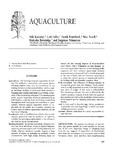Aquaculture
Share
Abstract
Aquaculture, the aquatic counterpart of agriculture, has grown rapidly in recent decades to become one of the most important means of obtaining food from the sea. Impacts of aquaculture on biodiversity arise from the consumption of resources, such as land (or space), water, seed, and feed, their transformation into products valued by society, and the subsequent release into the environment of wastes from uneaten food, fecal and urinary products, and chemtherapeutants as well as microorganisms, parasites, and feral animals. Negative effects may be direct, through release of eutrophicating substances, toxic chemicals, the transfer of diseases and parasites to wild stock, and the introduction of exotic and genetic material into the environment, or indirect through loss of habitat and niche space and changes in food webs. Today, large quantities of fish are caught to produce fish meal–the main ingredient in feed–which may result in overfishing and affect marine food chains, including marine mammals and top carnivores. In some types of aquaculture, fish and shrimp larvae are caught in the wild to be used as seed. This may also result in bycatches of large amounts of other larvae, representing losses to capture fisheries and biodiversity. Large areas of critical habitats such as wetlands and mangroves have been lost due to aquaculture siting and pollution, resulting in lowered biodiversity and recruitment to capture fisheries. The magnitude of biodiversity loss generally increases with scale, intensity of resource use, and net production of wastes, but it is very much dependent on which species is cultured and the method of cultivation. In some cases aquaculture may increase local biodiversity, e.g., when ponds are constructed in dry areas and with integrated aquaculture.
Suggested Citation
Kautsky, N., Folke, C., Rönnbäck, P., Troell, M., Beveridge, M., & Primavera, J. (2001). Aquaculture. In S. A. Levin (Ed.), Encyclopedia of Biodiversity (Vol. 1, pp. 185–198). New York: Elsevier.


